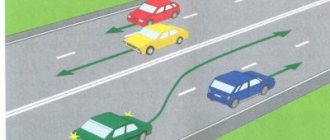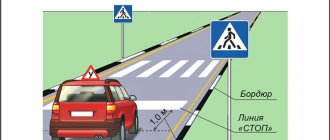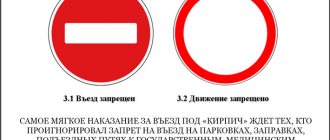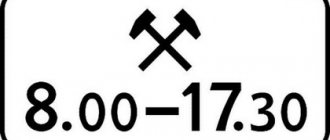One of the central problems of traffic rules is the issue of advantage or lack thereof. Road traffic is specially organized in such a way as to minimize the inconsistency of these two concepts. Therefore, almost always (with rare exceptions) the problem of advantage is resolved clearly: someone has it, and someone must respect someone else’s preemptive right. There is no third!
And if all road users religiously follow this commandment, then the practice of road accidents will be reduced to a minimum. Or it will disappear completely.
Don't believe it? Let's try to prove it with an example!
Typical situation: an accident at an intersection. The reason is the failure to provide priority rights to travel to a vehicle that had priority. That’s why respect for the advantage of another road user is the main principle of accident-free driving!
That is why the issues of advantage in movement seem to be the most important and relevant. We focus special attention on them.
Advantage (priority)
An advantage in traffic regulations is a right and a principle that can only be applied within the framework of real traffic. And traffic rules regulate priority issues with one goal - to streamline road traffic and ensure maximum safety for its participants.
The purpose of the Rules is to regulate the activity of all traffic participants in such a way that their activities, on the one hand, fit into some kind of harmonious system (and this is road traffic), and on the other, would not lead to an accident.
Definition from traffic rules (clause 1.2):
“ Advantage (priority) ” - the right to priority movement in the intended direction in relation to other road users.
If we simplify this definition, then a person or vehicle that has priority (or advantage) can carry out its plans before others - pass, pass, turn, etc.
Let's look at the most typical examples of priority.
1. Pedestrians crossing the roadway (or tram tracks) at an unregulated pedestrian crossing have priority.
Unfortunately, violation of this principle very often leads to terrible, monstrous consequences.
That is why special rules for passing pedestrian crossings are highlighted in a special section of the traffic rules (section 14).
2. The tram has priority in cases where the tram tracks cross the roadway outside the intersection (except when the tram leaves the depot).
Ignoring by drivers of this principle of advantage or even elementary inattention of the driver when traveling on tram tracks also leads to serious accidents.
In general, rail vehicles require increased attention.
3. Special vehicles with special signals (sound and light) performing an operational mission have an advantage.
The duty of the ordinary driver and pedestrians is to give them the right of priority.
4. A route vehicle that leaves a designated stop in a populated area has priority.
By the way, this rule is very often ignored by drivers who, either unknowingly or intentionally, do not notice minibuses pulling away from a stop.
We have considered a far from complete list of cases when a certain circle of road users has an advantage over other subjects. And, as Russian practice shows, the principles of advantage (or priority) are often violated. And an accident becomes an unpleasant, but natural result of this violation.
So, priority is the unshakable right of the driver of a vehicle or pedestrian to perform the intended actions first. The most common advantage granted to a driver by the Rules is being on a main road.
Main road (MR) – key priority indicators
The latest edition of the traffic rules provides for the presence of 13 such road signs. The two most important of them - 2.1 and 2.2 determine the beginning and end of the main road (main road). At most intersections of city transport arteries there is a sign 2.1. It gives the right of way to any motorist traveling on the main road towards the intersection.
In populated areas, priority signs are placed at each road intersection.
Traffic regulations make it possible to install such signs outside settlements, because outside the city traffic safety is no less important. Outside the city, the described priority indicator is placed:
- at the beginning of the entrance to the State Duma;
- in sections of the main engine turn (change of direction);
- before the heavy ones for the road;
- at the end of the GD.
Traffic regulations require that before complex intersections the 2.1 sign should be placed 150–300 meters away. This allows road users to prepare for the turn in advance. When the highway changes direction at any of the intersections, a table “Direction of the highway” (8.13) is mounted under the sign. It shows where the main road turns after crossing the highways.
The fact that the traffic mode has ended is indicated by the traffic rules indicator 2.2. A warning is sometimes placed underneath it - “Give way” (2.4), if the end of the main road occurs in a place before the intersection, where other drivers have the right of priority.
These traffic rules include seven road signs:
- “Intersection with a route of secondary importance”;
- “Adjacent to the secondary road on the right” – three signs;
- “Abutment on the left” – also three signs.
These are traffic priority signs, although in form they are warning signs. They determine the order of crossing intersections and point out to drivers the features of difficult places where several roads converge (intersection configuration), and also draw the attention of drivers to potentially unsafe areas of the road.
In cities, such road signs are placed 80–100 m from complex intersections, outside the city – 150–300 m.
They are very important for drivers, as they warn of places where they may be in danger of getting into an accident.
the main road
The main road is the main, most common concept that a driver encounters in traffic.
Looking ahead, let's say that when moving along the main road, the driver has an advantage over those participants who are not on it.
Definition from traffic rules (clause 1.2):
“ Main road ” - a road marked with signs 2.1, 2.3.1-2.3.7, 5.1, in relation to the one being crossed (adjacent), or a road with a hard surface (asphalt and cement concrete, stone materials, etc.) in relation to the dirt road , or any road in relation to exits from adjacent territories. The presence of a paved section on a minor road immediately before the intersection does not make it equal in importance to the one it intersects.
Quite a capacious and complex definition. Let's try to break it down into its components in order to understand and understand the main examples of the main road. But first we note one thing: the main road can only be such at some intersection. Otherwise, it is nonsense: a road can be recognized as the main one only in relation to some other road - which is not the main one at the intersection!
1. The main road is marked with special signs.
The easiest way to determine the “main” of the road is to see the following road signs on your way through the intersection.
In other words, when driving through an intersection under the indicated road signs, the driver will have priority over those traffic participants who enter this intersection from a secondary road.
However, the driver should not forget: at any intersection there is - at least! – two entrances to the main road. And the priority of any of the “main” participants is determined by other sections and principles of the traffic rules.
2. The main road is a paved road in relation to a dirt road.
This rule is actively used in practice when crossing roads with field, forest and other roads, which are not always advisable (at least from an economic point of view) to provide such intersections with priority signs.
This is where it’s important not to make a mistake! Paving stones and rubble stone are also hard surfaces. Just like asphalt! And a road paved with brick, concreted, lined with reinforced concrete slabs will be equivalent in relation to the asphalt section of the road. It's all hard surface! And, therefore, the specified priority rule will not work here.
Roads with different hard surfaces will be of equal importance.
And here's another thing! A small “eye” of asphalt at the border of the intersection with a “hard” road does not make the primer equivalent.
The notorious “eye” was created specifically so that the driver, leaving the dirt road, stops on the asphalt area and cleans the wheels of his car from dirt and other attributes of the unpaved surface adhering to them (so as not to carry all this dirty tricks onto the highway).
3. The main road is the road in relation to any exits from any adjacent territories.
Let us remember that the adjacent territory is the territory that is directly adjacent to the road. And such areas are considered to be courtyards, gas stations, parking lots, etc. We also know that exits from the adjacent territory are not considered intersections.
Now it is important to remember that at intersections associated with such exits, the main road will be any road on which drivers leave from adjacent territories.
And this rule works regardless of the installation of priority signs at such intersections.
Thus, the main road can be designated in three ways:
- priority signs indicating the right of way and the “Motorway” sign (5.1);
- the ratio of the paved road (main) to the dirt road (secondary);
- the relationship of the road (main) to the exit from the adjacent territory.
Priority signs.
Priority signs are placed in a separate section of signs in the traffic rules. Moreover, they have an absolutely recognizable, individual geometric shape, which can be recognized even from the reverse side.
Priority signs have the third most important priority (after traffic controllers and traffic lights). Therefore, if we approach an intersection where there is no traffic light or it is not working, we look for priority signs with our eyes. If we are on the main one, we have an advantage, if on the secondary one, we let those who are on the main one pass.
Ready to share unique information! Almost everyone who has attended a driving school knows that a “give way” sign means that you are in the secondary lane. But almost no one knows that a “stop” sign or “no passing without stopping” means the same thing. This is just some kind of universal discovery for all our students. Although everyone, or almost everyone, knows that this sign implies a complete stop.
So, we also sorted out the priority signs.
Give way
The flip side of priority is the requirement to give way. The logic of movement is precisely determined by the simultaneous requirement for drivers to either take advantage of their advantage or give way.
Definition from traffic rules (clause 1.2):
“ Give way (do not interfere) ” is a requirement that means that a road user must not start, resume or continue moving, or carry out any maneuver if this may force other road users who have priority over him to change direction. movement or speed.
Despite the cumbersome definition, it is not at all difficult to understand. A traffic participant who is obliged to give way must do everything possible and necessary to ensure that through no actions he creates interference with a traffic participant who currently has priority.
A very common case: giving way to a pedestrian at a pedestrian crossing. This is a sacred thing!
Note that traditionally drivers associate the concept of “giving way” with the concept of “letting pass.” This is not entirely correct, but very close to reality at the applied, practical level. In reality, the “Give way” requirement is quite insidious. It does not mean an unconditional requirement - be sure to stop and let the priority traffic participant pass, faithfully watching how he drives or passes by. This is a very subtle matter, but you need to understand it.
Giving way is a requirement not to interfere with the participant who currently has priority. And if by our actions we cannot create these same obstacles, then we have the right to continue performing the action we have planned (maneuver, movement, etc.).
To demonstrate this statement, we give several examples.
Example one.
A truck driver on the main road is about to turn left, and we are about to turn right. Our trajectories – in principle! - do not intersect. Therefore, we can continue driving without interfering with the truck. In this case, we will comply with the requirement of the “Give Way” sign, but only after making sure that we do not interfere with it.
Example two.
The driver of a car is about to start driving. His duty is to give way to vehicles already moving on the roadway. But the truck is moving in the second lane, and the driver of the car will not interfere with it through his actions. Basically! That is why he can start moving, because he will not violate the requirement - to give way to the truck.
Example three.
The motorcyclist, judging by the road signs, has the right of way on the narrow bridge. However, there is a high probability that, driving along this narrow section of the road at the same time as a motorcyclist, we will not make it difficult for him to move (due to his small dimensions). Basically! Therefore, having made sure of the last circumstance, we can drive onto the bridge in parallel with the motorcyclist. But just without interfering with him!
And one moment. For many drivers, the concept of “Give way” is associated exclusively with the priority sign of the same name – “Give way”.
In fact, this concept is much broader. As well as much broader issues of priority, which are not limited to the “Main Road” sign. It is important to remember that the presence of an advantage for one participant in the movement automatically means a requirement to give way (that is, not create interference) for other participants.
This is the logic of accident-free traffic!
Right hand rule
There is no such rule in the traffic rules. More precisely, it exists, but precisely such a concept does not exist. This is an invention of the drivers themselves, traffic rules teachers, practical driving instructors - the “right hand rule”, “take care of your right side”, “interference on the right”. And this rule sounds like this: you must give way to obstacles on the right.
Rule from the traffic rules (clause 1.2):
In cases where the trajectories of vehicles intersect, and the order of passage is not specified by the Rules, the driver to whom the vehicle is approaching from the right must give way.
Unfortunately, ignorant drivers apply this principle left and right, regardless of the requirements that apply to this rule. But in vain! The right-hand rule has conditions under which it works (and under which it cannot and should not apply).
Let's look at this rule in more detail.
Let's imagine an intersection that is not marked by either priority signs or traffic lights. And the traffic controller didn’t have time to get here either. How can vehicles pass each other at such an intersection?
According to the “right hand” rule! A driver who has an obstacle on the right must give way to this obstacle. It’s easier to skip it!
When can we apply this rule?
1. The order of travel should not be specified in the Rules.
This is a fundamental requirement: the actions of drivers driving according to the “right hand” rule should not be regulated by other traffic rules. Only in this case can this principle of priority be applied.
2. Participants in the movement must be equal.
Thus, it is impossible to apply the “right hand” rule in the system of relations “pedestrian – vehicle”.
Also, this rule cannot be applied in the “tram – trackless vehicle” system.
These relationships are regulated by the Rules, therefore the “right hand” rule cannot be applied to them.
And one moment. This rule is universal; it can be applied in any situation, but subject to the two conditions discussed above. And, of course, the trajectories of movement must intersect.
A simple check of the drivers' KBM using the AIS RSA database for compulsory motor liability insurance in some cases will help you get a discount when applying for a policy.
How to pay for parking in Moscow by SMS or other methods.
Check light in the car possible causes.
What to follow when driving through an intersection?
The answer to this question should be given when considering road signs, since they also determine the order of travel.
On the road there is the following hierarchy (I presented it in the form of a picture):
If there is a traffic controller at an intersection, and he participates in organizing traffic with his gestures, then he is in charge here and no matter what traffic light signal is on, the traffic controller’s gestures cancel it.
If there are priority signs at the intersection and a traffic light operating in three-color signaling mode, then it is he who determines the order of passage. Why did I focus on the traffic light operating in normal mode, because its operation in the “yellow flashing light” mode makes the intersection unregulated.











